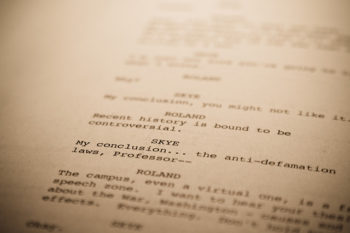“Use the Force, Luke.” It’s one of the most iconic phrases in the history of film – and if you haven’t heard it before, you must have been living on a backwater desert planet for the last forty years.
It also contains a valuable lesson for writers. In our latest Writing Insights article, Edward Smith takes a look at how these four words unlock the secrets of the character arc.
And a quick warning if you’ve been living on that desert planet… This article contains spoilers for the original Star Wars trilogy.
We all want to write memorable characters with plenty of depth, and any writer who knows their craft knows that the key to this is the character arc: a process of change and growth that a character undergoes in the course of the story. A character who changes pops off the page and the screen because they are reacting to the world they inhabit, as real people do, whereas a static character is forever nothing more than a two-dimensional collection of traits.
 Yet change just for the sake of change is not enough. The very best character arcs do something more: they equip the hero with the qualities they need to emerge victorious. If your thoughts just went to every training montage you’ve ever seen, you’re on the right lines, but to maximize this concept it needs to be taken further. Skills and knowledge are one thing, but gaining the wisdom to make use of what they know – that is what makes a character’s journey truly satisfying.
Yet change just for the sake of change is not enough. The very best character arcs do something more: they equip the hero with the qualities they need to emerge victorious. If your thoughts just went to every training montage you’ve ever seen, you’re on the right lines, but to maximize this concept it needs to be taken further. Skills and knowledge are one thing, but gaining the wisdom to make use of what they know – that is what makes a character’s journey truly satisfying.
And this is where we come to our key phrase. “Use the Force, Luke.”
In the original Star Wars trilogy, the character arc is applied brilliantly – and differently – in each of the three films. Luke Skywalker undergoes three arcs, each one concluding in a different fashion, showing us how invaluable it is to fully understand this concept.
Episode Four: A New Hope
Luke starts out as a mere farmboy who could never triumph against the might of the Empire. In the course of his adventures, however, he grows into a hero who is entrusted, in the film’s climax, with the task of destroying the Death Star. Yet even then, even with all he has learned, he comes dangerously close to failure, and it takes a reminder from Obi-Wan Kenobi to make sure he doesn’t repeat the mistakes of those who came before him. “Use the Force, Luke.” Luke now has the wisdom to listen – and is rewarded with victory.
Episode Five: The Empire Strikes Back
Here we find the character arc used to different effect – in fact, in entirely the opposite manner. After going to train with Jedi Master Yoda, Luke leaves before he is ready despite the warnings of his teacher – and, erm… It doesn’t end well for him. At all. This is fundamentally the tragic form, in which the hero fails to learn what they need to succeed – although unlike most tragic heroes, Luke is lucky enough to escape with his life.
Episode Six: Return of the Jedi
Luke actually has little physical impact on the film’s conclusion. While the Rebellion faces off against the Empire (albeit aided by teddy-bears), Luke is locked in a personal battle with Darth Vader and the Emperor, emerging with a moral victory by having the wisdom to know when to stay his hand. While it doesn’t directly affect what happens elsewhere, his arc is nonetheless satisfying because it has a karmic effect; his moral victory is rewarded within the story by simultaneous success for his friends in the Rebellion.
So what can we learn from this? The original Star Wars trilogy demonstrates how a character arc is not merely about growth, but growth with purpose, giving a character not merely the skills they need but also the wisdom to use them. It also shows how an arc can be used in different ways: to give your protagonist success, disaster, or a moral victory.
So whichever kind of character arc you opt for in your script, you now have all the information you need – just make sure you have the wisdom to use it…

